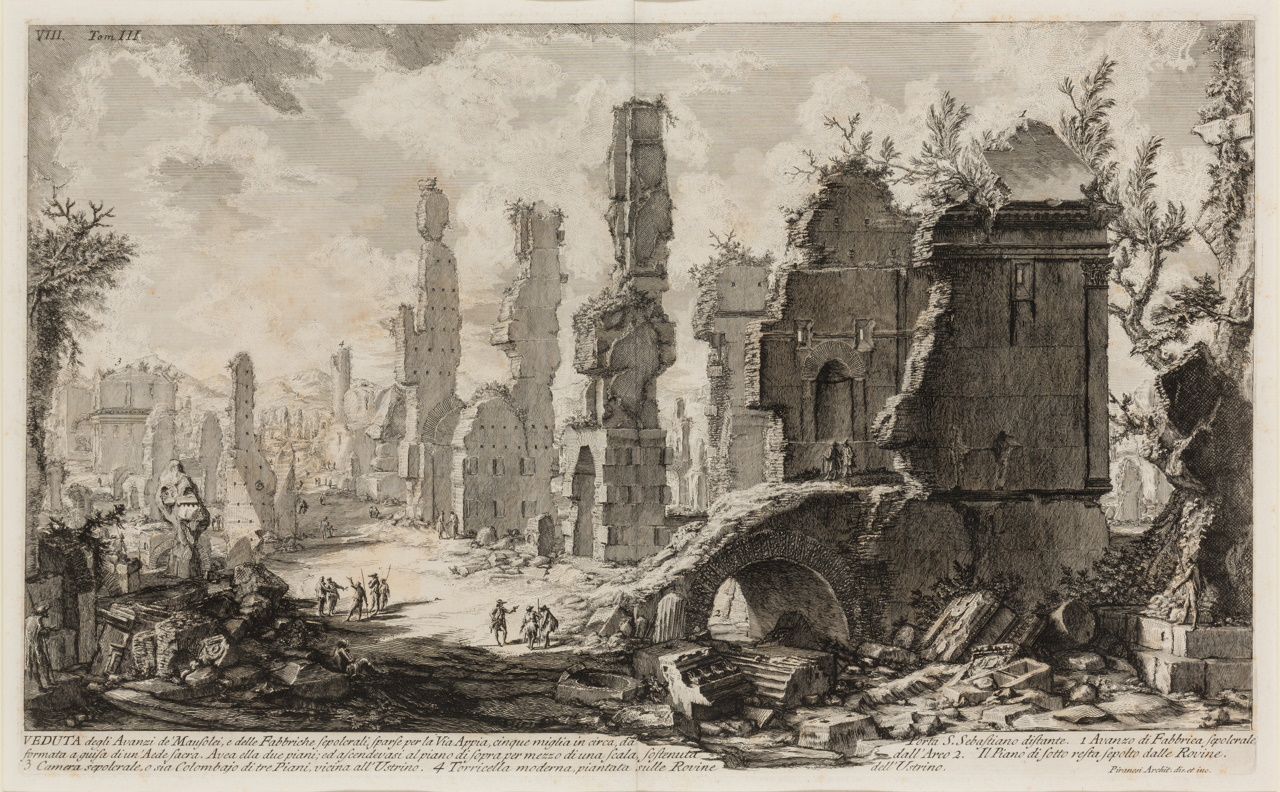
Giambattista Piranesi
Italian, 1720-1778
"View of the remains of the mausoleums and sepulchral complexes dispersed along the Appian Way"
From The Antiquities of Rome (first edition ca. 1756)
n.d.
Etching
Gift of Alex Neshkes, 1986.533
During the late seventeenth through the mid-nineteenth century those with financial means completed their education by taking the "Grand Tour" through Europe. The trip, usually for young men accompanied by a teacher or guardian, could last months or years. The city of Rome was one of the must-see places, along with the environs of Naples where towns buried by Mount Vesuvius in 79 ce were being unearthed. Artists and architects also went to Rome to study the structures of the past. This throng of travelers provided a market for painters and printmakers who created views that could be taken home as souvenirs, much like snapping a photo today. Piranesi's view along the Appian Way in Rome would have appealed to antiquarians, artists, architects, and tourists.
On the left, the brightly lit road lined by ruins of walls leads to the foreground where architectural elements are piled up and extend beyond the border of the print. In the text at the bottom, Piranesi describes the site: "View of the remains of the mausoleums and sepulchral complexes dispersed along the Appian Way, about five miles from the Porta San Sebastiano." He added numbers to the surface of the print so viewers would know where to find the structures he identified and explained:
-
1 [above the building on the right]: Remnant of a sepulchral complex in the form of a sacred Aedes, or temple. This was composed of two floors: the upper floor was reached by means of a staircase supported by the arch labelled 2.
2 [inside the arch near the center] The lower floor remains buried beneath the ruins.
3 [at far left above the building]: Sepulchral chamber, or Columbarium, composed of three levels, near the Ustrinum [a sacred space for cremation of mortal remains].
4 [to the right of #3] Modern tower erected on the ruins of the Ustrinum.
Piranesi's precise labeling of the scene would have appealed to those who traveled to Rome to learn about its past. At the same time, he creates a sense of drama with shadows obscuring the ruins in the foreground and with bright white clouds overhead. He included a few figures who walk on the path between the structures. Some almost disappear as they walk toward the hills in the distance, and others closer to the foreground gesture as they converse. They may be the antiquarians, guides, travelers, or locals who frequented the area. Piranesi's training in architecture, painting, drawing, stage set design, and engraving contributed to the style of the print. He also traveled to the environs of Naples to study the unearthed structures at Herculaneum, Pompeii, and Paestum. His knowledge and experiences are reflected in the prints in this series that focused on ancient architecture.
Bibliography
Le Antichità Romane (The Antiquities of Rome). Rome: Bouchard and Gravier, 1756. 4 vols. For digital version, see University of South Carolina, University Libraries: https://digital.tcl.sc.edu/digital/collection/piranesi/search
Ficacci, Luigi. Giovanni Battista Piranesi: The Complete Etchings. Köln: Taschen, 2000.
Kissane, Conor. Translation of text of the print, "View of the remains of the mausoleums and sepulchral complexes dispersed along the Appian Way (Veduta degli avanzi de’ mausolei e delle fabbriche sepolcrali sparse per la Via Appia)."
Penny, Nicholas. Piranesi. London: Oresko Books, 1978.
Perlove, Shelly, ed. Piranesi’s Views of Rome. Dearborn: University of Michigan-Dearborn, 1986. Exhibition catalogue. (See Entry 22, p. 64).
"Piranesi, Giambattista." Benezit Dictionary of Artists. New York: Oxford University Press, Oct. 31, 2011. https://doi.org/10.1093/benz/9780199773787.article.B00142489